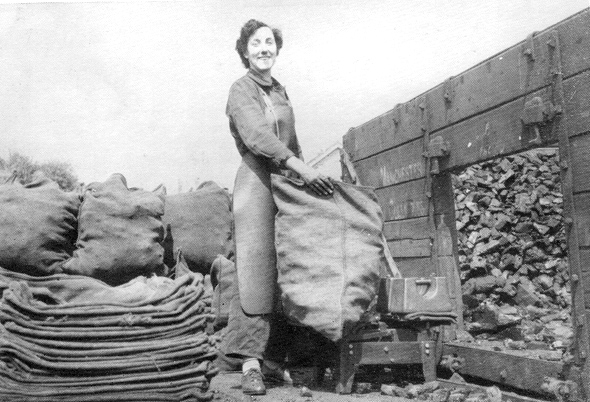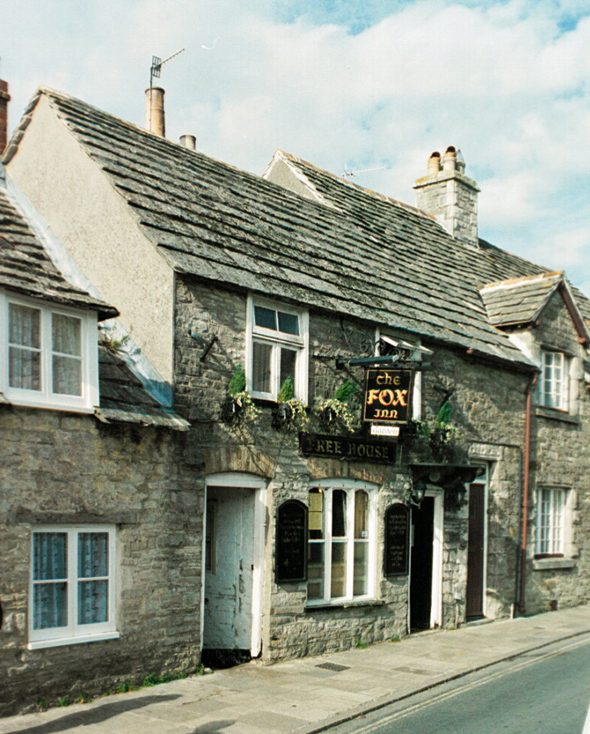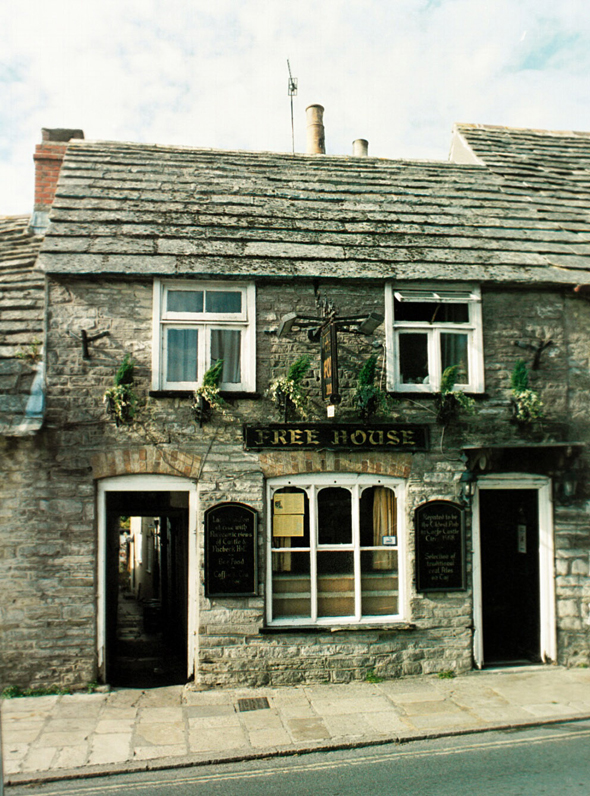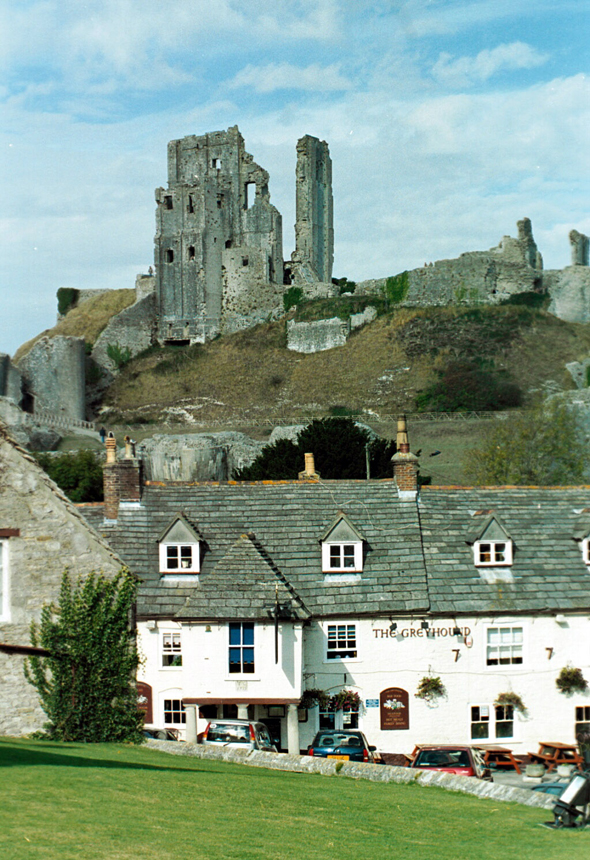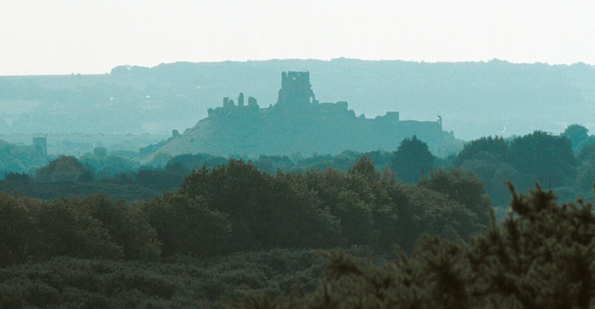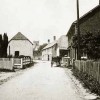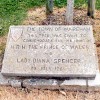The ruins of Corfe Castle rise majestically above the town that shares its name. Here is a structure that in its day was one of the most impregnable fortresses in the kingdom: so strong, the ascent so steep, and the walls so massive it was virtually unassailable and commanded the area in the south-east of Dorset that we call the Isle of Purbeck.
These one hundred or so square miles bounded in the north by the River Frome and Poole Harbour, the waters of the English Channel making land fall on the east and south; on the west is Luckford Lake and the parish of East Lulworth. From the head of Luckford Lake south to the English Channel, a distance of about two miles, there is no water boundary so the area might more accurately be called the Purbeck Peninsular.
Straddling east to west across the middle of the island are the Purbeck Hills.The most easterly is known locally as Ballard Down, and then going west to Nine Barrow Down, Challow Hill, Knowle Hill and Purbeck Hill, effectively dividing Purbeck into two roughly equal parts. Between Challow and Knowle Hills is a gap filled by a steep rocky mount upon which sits Corfe Castle. Corfe is Anglo Saxon for gap and in Saxon times it was known as Corfe Gate. The Danes arrived in the area in 876 A.D. destroying the nearby town of Wareham only to be beaten back to the sea the following year by Alfred’s warriors. Their escape in over a hundred boats was thwarted by Alfred’s ships and bad weather; all of the Danes perished in the waters off Swanage.
During the next century the castle was enlarged by King Edgar who resided here and it was Edgar who was most likely responsible for building the central Keep. King Edgar died aged only thirty-three; his widow Elfrida inherited the castle and it is here she plotted the murder of her stepson, Edward the Martyr, clearing the way for her own son Ethelred to become King.
Known as Ethelred the Unready he, by his procrastination, allowed the Danes to over run and plunder much of the southern coast of England including Dorset, but they could not take Corfe Castle. Ethelred had granted the Danes rights over the Kingdom while at the same time plotting to massacre them, his plans exacerbated when hordes more arrived. He fled the country to return later; his reign ended in 1007 and his dynasty was brought to a close by the Norman invasion of 1066.
After the Norman’s took control Corfe Castle followed the fortunes of the Crown and was held as a royal property on behalf of the Conqueror and his descendants and work on the castle proper began.
During the Civil War between Stephen and the Empress Maude (Matilda) Corfe Castle was held by the dependants of Maude. It held out gallantly and defied all Stephen’s efforts to take it. At the close of the war in 1153, the Castle submitted to the authority of the de facto ruler Stephen, but unlike many other strongholds it was not dismantled and on the death of Stephen, which occurred in the following year, the defenders proudly welcomed Henry II as their Sovereign (Henry was Matilda’s son). The castle was a Royal possession during the reign of Richard I.
It is said that Corfe Castle was King John’s favourite residence. He deposited his treasure and regalia here, probably because of the security it provided and he further increased its defences. It also served as his State prison. When the King was away from the castle his Constable, Peter de Mauley, was in charge.
Following John ‘s death de Mauley loyally delivered the castle with its treasures and military supplies to the Earl of Pembroke who was Lord Protector of the Kingdom during the infancy of King Henry III. Amongst the regalia handed over by de Mauley was the crown which had been worn by the Anglo Saxon kings and it was used at the coronation of the young Prince Henry.
Pembroke died while Henry was still a child but before his death he released King John’s prisoners including those held at Corfe. Amongst the prisoners released from Corfe Castle were Marjory and Isabel, daughters of the Scotch King William. But for another prisoner – Eleanor, known as “The Damsel of Brittany”, the outcome was not so good; she was incarcerated at Bristol where she spent the next forty years until her death.
Nine years after Pembroke’s death Peter de Mauley forcibly seized the castle for Simon de Montfort who held it as security for King Henry III’s future good conduct. During that time and the reign of the ill-fated Edward II the castle was greatly improved and strengthened.
It was Richard II who granted the Manor and Castle of Corfe to Thomas Holland, Earl of Kent and Alicia his wife. After their deaths Henry IV assigned the castle to John Beaufort, Earl of Somerset, who with his heirs held it during the Wars of the Roses when the castle remained free from attack. But at the close of the reign of Henry VI and after the Battle of Tewksbury on 4th May 1471 the then owner, Henry Duke of Somerset, along with other prisoners was executed in the market square of the Gloucestershire town.
Somerset’s estates including the Castle and Manor of Corfe were granted by Edward IV to his brother George, Duke of Clarence, who was later charged with high treason by Parliament in January 1478 and drowned in a butt of malmsey on the 18th of February; the castle and manor then reverted to the Crown.
When Henry VII became King he granted Corfe to his mother, Margaret, Countess of Richmond, daughter of the Duke of Somerset, whose tragic end at Tewkesbury we have referred to. She survived her son by only one year and on her death in the first year of the reign of Henry VIII the castle again reverted to the Crown.
In the twenty-seventh year of his reign Henry VIII granted the Castle and Manor of Corfe, together with the Island of Purbeck, to his illegitimate son Henry Fitzroy, Duke of Richmond and Somerset, but on the death of this nobleman thefollowing year, the estate again reverted to the Crown and remained a royal possession until Henry VIII’s death, when it was annexed as his private property by Seymour, Earl of Hertford and Duke of Somerset, the guardian and protector of the youthful King Edward VI. On the fall of that powerful noble in 1553, it once more became a Royal castle.
And that is how the situation remained until the fourteenth year of Elizabeth’s reign when all rights over the Manor and the Castle as well as the Isle of Purbeck were granted to Sir Christopher Hatton, Knight. Sir Christopher spent a small fortune restoring and improving the castle making it a prestigious home with fine furnishings, tapestries and silks. When the Armada was threatening, the castle’s defences were again strengthened.
Sir Christopher died in 1591, just four years after his appointment as Lord High Chancellor. He was single and all his possessions, including Corfe Castle, passed to his nephew Sir William Newport, who assumed the name Hatton by royal licence on succeeding his uncle. When he died in 1597 his second wife Elizabeth, daughter of Thomas Cecil, Earl of Exeter, inherited all his possessions.
Lady Elizabeth Hatton, after turning down advances from Francis Bacon, married Sir Edward Coke five months after the death of his first wife; it was a complicated relationship but what interests us is that on the death of Sir Edward Coke in September 1634 Lady Elizabeth Hatton (she refused to use her husband’s name) sold Corfe Castle and all her possessions in Purbeck to the Attorney General of the day, Sir John Bankes.
Sir John Bankes established his family in the castle and acquired other land and property in Dorset. Lady Bankes resided in the castle while her husband was away attending the king. She was a woman of great courage and, anticipating the storm that was to break around her, she prudently put the castle’s defences on a state of alert, stocking up with food and military supplies. She heroically held the castle for thirteen weeks when attacked by the Roundheads.
When Sir John Bankes returned to Corfe Castle he found that thanks to the heroism of his wife and family the castle was safe and his property preserved. The same could not be said for the town, which was destroyed, the inhabitants having to retreat within the gates of the castle.
In January 1644 Sir John returned to his duties with the King. By mid summer the Royalists were losing the war: Weymouth and Wareham had fallen to the Parliamentarians and Corfe Castle remained the only stronghold between Exeter and London still holding out for the King. Lady Bankes received news of her husband’s death on the 28th of December 1644. Throughout the winter of 1644 and 1645 the Bankes family, barricaded inside the castle, survived all manner of assaults. Still Corfe Castle held out for the King.
Late in 1645 orders were issued for more determined action to be taken to secure Corfe Castle. For this purpose two regiments were placed at the disposal of Colonel Bingham, Governor of Poole, and further reinforcements were despatched to help during December. Following an act of betrayal by someone in the castle it was finally captured by the Parliamentarians.
Lady Bankes surrendered the Castle on the 27th of February 1646 and on the 5th of March the House of Commons voted to demolish the castle and this was done with some vigour but only after it had been plundered. Carried away were rich tapestries and furniture from the days of Sir Christopher Hatton as well as goods belonging to Lady Bankes and her family.
Today the National Trust protects what remains of the Castle and archaeological excavations are promoted to reveal more of the castle’s past. Corfe Castle is part of the huge Kingston Lacy estate left to The National Trust in 1981 by Ralph Bankes, a direct descendant of Sir John Bankes.
This was home to Kings, a place where a King was murdered, intrigues were plotted, prisoners of state were held, and for a while it was the stately home of wealthy and important families. It is much more than a pile of stone and rubble, the ruined Keep towers over the town a constant reminder of its place in the history of the Kingdom.
